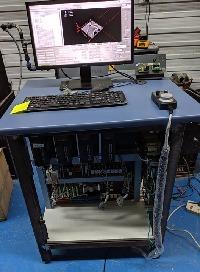Tuning issues (RESOLVED)
- Todd Zuercher
-

- Offline
- Platinum Member
-

Less
More
- Posts: 4689
- Thank you received: 1433
19 May 2017 13:48 #93384
by Todd Zuercher
Replied by Todd Zuercher on topic Tuning issues
Are you sure that you are monitoring the exact same conditions when you are using halscope vs cutting the wiggly line? The screen shots you posted looked like they were taken during a short linear jog. The picture of your problem cut looked like a direction reversal with a multi axis move. It is easily possible the problem is present in one situation and not the other.
Please Log in or Create an account to join the conversation.
- jmelson
- Offline
- Moderator
-

Less
More
- Posts: 516
- Thank you received: 125
19 May 2017 16:34 #93387
by jmelson
One way a control systems engineer would attack this is by attaching an accelerometer to the axis, and plotting perhaps servo drive against the accelerometer. Use a digital scope with FFT feature to extract the frequencies, then put notch filters over the peaks in the FFT and see if that fixes it. The accelerometer could be placed near the spindle to see what will actually occur at the cutting tool. You could also use the accelerometer to analyze the effect of improvements to the axis mechanical condition.
Jon
Jon
Replied by jmelson on topic Tuning issues
Halscope can only see what the encoder sees. And, the servo loop strives to make the encoder follow the commanded position. So, even if the machine is vibrating, the PID will actively strive to REMOVE the vibration from the encoder's position, even if that makes the vibrations WORSE! This is the whole issue of mechanical resonance. What you need is to make the natural frequency of the mechanical system higher than the servo bandwidth. This can be really hard to do, and is why milling machines have tons of cast iron in them. If you can't make the natural frequency of the mechanicals higher than the servo bandwidth, then you need to put notch filters in the servo system to eliminate response to the resonance. That can be done in velocity servo systems with tachometer feedback.Yes but I don't see any instability in halscope, but on the machine you do. So the interpretation halscope is doing is not that accurate in my opinion..
One way a control systems engineer would attack this is by attaching an accelerometer to the axis, and plotting perhaps servo drive against the accelerometer. Use a digital scope with FFT feature to extract the frequencies, then put notch filters over the peaks in the FFT and see if that fixes it. The accelerometer could be placed near the spindle to see what will actually occur at the cutting tool. You could also use the accelerometer to analyze the effect of improvements to the axis mechanical condition.
Jon
Jon
Please Log in or Create an account to join the conversation.
- jmelson
- Offline
- Moderator
-

Less
More
- Posts: 516
- Thank you received: 125
19 May 2017 16:36 #93388
by jmelson
Problems at a direction reversal strongly indicate a backlash problem. And, of course, if resonance issues are present, backlash will likely make them a lot worse!
Jon
Replied by jmelson on topic Tuning issues
The picture of your problem cut looked like a direction reversal with a multi axis move.
Problems at a direction reversal strongly indicate a backlash problem. And, of course, if resonance issues are present, backlash will likely make them a lot worse!
Jon
Please Log in or Create an account to join the conversation.
- tommylight
-

- Away
- Moderator
-

Less
More
- Posts: 20993
- Thank you received: 7159
19 May 2017 18:17 #93390
by tommylight
Replied by tommylight on topic Tuning issues
I think i mentioned this in the servo tuning tutorial, but an easy way to measure acceleration and vibration on the machines is to use a mobile phone or a tablet. I use a samsung galaxy tab s 10.5 for that with whatever software for ploting live acceleration and zoom in to see realy smal diferences in the plot.
For all intents and purposes it is very useful, todays phones have plenty of sensors and quite sensitive.
For all intents and purposes it is very useful, todays phones have plenty of sensors and quite sensitive.
Please Log in or Create an account to join the conversation.
- bevins
-
 Topic Author
Topic Author
- Offline
- Platinum Member
-

Less
More
- Posts: 1942
- Thank you received: 338
20 May 2017 00:07 #93391
by bevins
Replied by bevins on topic Tuning issues
There is not enough backlash for me to even measure. There's hardly no backlash in these axis, especially to make the cuts the way it was cutting.
The P was simply too high and I couldn't see it in the halscope and probably what John was mentioniong. I could feel it in the axis. dropped the P and everything is working perfectly.
The P was simply too high and I couldn't see it in the halscope and probably what John was mentioniong. I could feel it in the axis. dropped the P and everything is working perfectly.
Please Log in or Create an account to join the conversation.
Time to create page: 0.065 seconds
